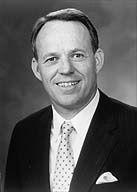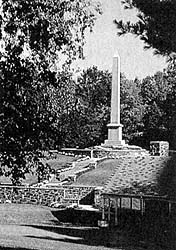“Conversation: Church Historical Sites,” Ensign, July 1996, 79–80
Conversation: Church Historical Sites
With next year’s approaching 150th anniversary of the arrival of the Latter-day Saint pioneers into the Salt Lake Valley, members are encouraged to renew their acquaintance with—or, for those who are able, experience for the first time—the many historical sites associated with the Restoration of the gospel that have been developed across North America. For an update about the Church’s efforts in establishing historical sites, the Ensign spoke with Elder Stephen D. Nadauld of the Seventy, executive director of the Church’s Historical Department and chairman of the Historic Sites Committee, and Elder Earl C. Tingey of the Seventy, assistant executive director of the Church’s Missionary Department and vice chairman of the Historic Sites Committee.


Elder Stephen D. Nadauld Elder Earl C. Tingey
Question: Can you give background on why the Church devotes resources to restoring and developing historical sites?
Answer: Whenever a group of people make the effort to better learn and understand their heritage, those people will be strengthened. Nephi demonstrated this in the Book of Mormon when he rehearsed the history of his ancestors to remind his people of who they were (see 1 Ne. 17). From the early events of the Restoration to the trek of the pioneers across the plains, we too have a rich heritage in the Church today. By studying about and, when possible, visiting the sites of important events and revelations, we can gain an unusually strong understanding of and connection with our past.
The purpose of the Church’s historic sites program is to strengthen the faith of members and to interest others in the restored gospel by increasing visitors’ understanding of the significant events, buildings, and sites in Church history and of associated gospel principles. At sites where visitors’ centers have been established, our purpose expands to invite all to come unto Christ by providing visitors with an opportunity to learn more about our beliefs and accept an invitation for missionaries to teach them the gospel.
Q: How do the historical sites accomplish their purpose?
A: Elder Nadauld had a wonderful experience last summer at the restored Whitney Store in Kirtland, Ohio, that illustrates the impact historical sites can have on individuals. As he entered the store, he noticed all the authentic artifacts—sacks of beans on the floor, 19th-century products on the shelves—that can help a person imagine what life was like during the important events that happened there. What really affected him, however, was the presentation of a young sister missionary. After experiencing her testimony about the spiritual events and inspired efforts that took place in the Whitney Store, Elder Nadauld felt renewed faith and a greater desire to understand the people who participated in those events and what motivated them. Showing and discussing historical facts is a powerful teaching tool, and when missionaries add their testimonies about what occurred, the hearts of visitors are often touched by the Spirit.
One of the most important functions of the historical sites is teaching others about the gospel. Many tourists are drawn to the sites, and we’ve found that members have first-rate experiences when they bring their friends to the sites and visitors’ centers. The missionaries who guide tours and give presentations are very sensitive to making sure visitors don’t feel trapped or pressured in any way; they want visitors to experience feelings of peace, faith, and testimony. Visitors often have chances to request visits from missionaries, but they are not pressed to do so. We encourage members to seek more opportunities to bring their friends and family members of other faiths to the Church historical sites and visitors’ centers.
Q: How can members get the most out of visiting the historical sites?
A: We have heard many reports of fun, successful family trips to the historical sites. Often just a father and mother may load up the car with their children and go, but we’ve also heard of extended families traveling from site to site in caravans or rented buses with Grandma and Grandpa and all the aunts, uncles, and cousins. We encourage families to take the initiative to experience Church history sites together because not only will they grow stronger and more unified in faith and testimony but family relationships can become closer. A Church history trip doesn’t have to be extravagant in terms of travel and lodging costs, and commercial maps and guidebooks and Church-published pamphlets are available to help in planning. Attending the pageants associated with many of the sites is a wonderful experience, but we also encourage members to visit Church history sites during less-crowded seasons.
Another form of preparation that can enhance a Church history trip is to read about the events and revelations before and during site visits. One very powerful way to experience the sites is to take along a copy of the Doctrine and Covenants and, using the section headings for guidance, read particular sections at the places they were received, such as the tender, touching passages the Prophet Joseph Smith recorded while in Liberty Jail. Many other helpful and interesting history and resource books and manuals are available through Church distribution centers and meetinghouse libraries, and at Latter-day Saint bookstores.
Q: What further development of historical sites is planned?
A: After years of groundbreaking work in sites from San Diego to Vermont in the United States, the historical sites program of the Church has reached a mature stage in which enhancement and preservation of existing sites are the focus now. For instance, the Grandin Building in Palmyra, where the Book of Mormon was first published, is undergoing renovations, and a replica of the log cabin where the angel Moroni appeared to Joseph is being added to the Joseph Smith farm. A new visitors’ center is being built at Winter Quarters in Iowa, and a new park is being developed at This Is the Place monument at the mouth of Emigration Canyon in Salt Lake City. With these two new anchors at either end, next year will be a good year for those who are able to honor the pioneers by retracing their route across the plains, visiting the many markers commemorating their sacrifices, and touring the homes and buildings they left behind in Nauvoo.
While the Church limits tithing-funded restoration and development efforts to those sites considered most universal and fundamental in importance and appeal to all members, we do encourage independent groups to get involved with the restoration and development of historical Church sites and buildings of more local interest. For example, a private group has put together a plan to rebuild the historic Kanesville tabernacle in Iowa. Even though that project did not fit the master plan of the Church’s Historical Sites Committee, we are extremely grateful and excited about what they are doing. Some of the supporters of the Kanesville project are not Church members but citizens who value history.
No better way exists for gaining a stronger sense of our heritage than studying about and, when possible, visiting Church history sites. Whether members visit a site that is simply marked with a sign, or a major site like Nauvoo, they will come away feeling more appreciative and inspired by our forebears’ sacrifices and efforts and more grateful for the Restoration of the gospel. They will understand better who they are and why they should strive to be more dedicated to the gospel cause. We’re grateful that the Lord has opened the way for the historical sites program of the Church to be a successful part of proclaiming the gospel and perfecting the Saints.

Joseph Smith’s birthplace in Sharon, Vermont. (Photo by Welden Andersen.)